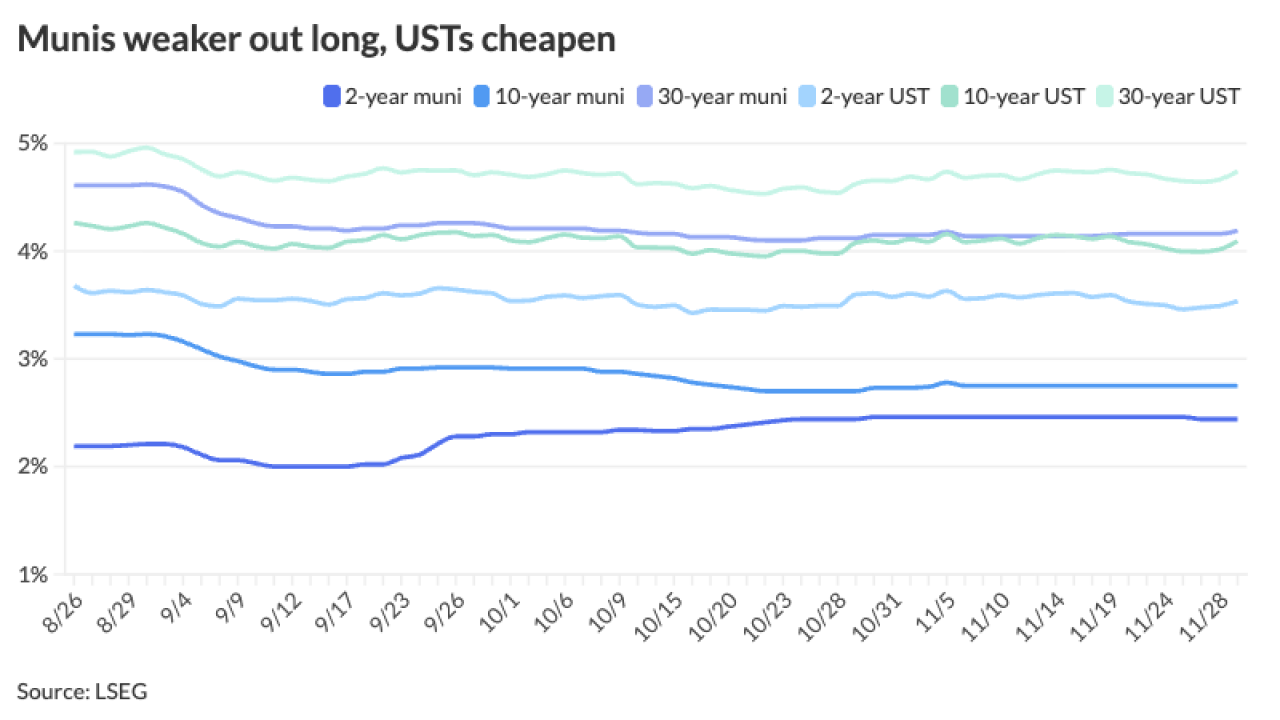
WASHINGTON — With financial regulators combing through pension reporting by state and local governments, the National Association of Bond Lawyers unveiled guidance Monday to boost issuers’ disclosure practices.
The
As a self-styled overview, the “basic guidance” addresses a host of issues, ranging from which documents to gather and review before drafting disclosure language to definitions of pension reporting terms.
At the same time, NABL announced plans to spearhead a pension-disclosure project among key players in the muni market, including actuaries, accounting firms, financial analysts, investors and issuers. After holding a series of roundtables, slated to begin next month, the group hopes to complete the project by the end of this year.
“I think it’s important,” said NABL president John McNally, a partner at Hawkins, Delafield & Wood LLP in Washington. “The market cries for it. And we’re stepping in.”
NABL’s move stems from heightened regulatory interest in disclosure by defined-benefit pension plans, especially at the Securities and Exchange Commission.
Defined-benefit pension plans include single-employer plans, multi-employer plans and cost-sharing plans. Unlike defined contribution plans, which determine how contributions are made, a defined-benefit plan focuses on how benefits are paid.
Last year, the SEC settled securities fraud charges with New Jersey, the first such settlement with a state. The commission charged that the state misrepresented and failed to disclose to investors — who bought more than $26 billion worth of the state’s muni bonds between 2001 and 2007 — that it was underfunding its two largest defined-benefit pensions.
New Jersey settled without admitting wrongdoing or paying a fine, but agreed to cease and desist from any future violations of the securities laws.
Currently, the SEC’s Boston office is probing pension-disclosure practices by Rhode Island, which recently hired McNally’s firm as disclosure counsel. Commission staff are also delving into whether troubled state and local borrowers, such as Illinois and Harrisburg, Pa., have provided accurate financial information to muni investors.
And in its first landmark pension case, the SEC brought securities fraud charges against San Diego for failing to disclose that it was intentionally underfunding its pension obligations in official statements, rating agency presentations and continuing disclosures related to more than $260 million in municipal securities issued in 2002 and 2003. In that 2006 case, city officials knew but did not disclose that they would be unable to fund future pension and health-care obligations without new revenues, benefit cuts or reductions in city services.
Meanwhile, Republican lawmakers on Capitol Hill have also plunged into the disclosure fray. Since taking control of the House earlier this year, they have convened a series of hearings on the financial health of state and local governments and public-sector pensions, which may be underfunded by as much as $3 trillion, according to a frequently-cited 2009 study in the Journal of Economic Perspectives.
The latest such panel will convene Thursday before an oversight subcommittee of the House Ways and Means Committee. In February, a member of that committee, Devin Nunes, R-Calif., introduced a bill, the Public Employee Pension Transparency Act, that would require state and local governments to disclose detailed information about their pension plans, including unfunded liabilities, using two rates: the discount rate they typically apply, the historic rate of return, which is roughly 7% to 8%, and a lower so called “riskless” discount rate pegged to Treasury rates, which is around 4% to 5%.
The Nunes bill would amend the federal tax code by requiring public-sector pension plans to file annual reports with the Treasury Department. Any state or local government that failed to do so would be barred from issuing new tax-exempt, tax-credit, or direct-pay bonds until it files the necessary report. According to the bill, current governmental accounting practices suffer from a lack of meaningful disclosure that obscures the value of plan assets and understates liabilities, posing a “significant threat” to the financial stability of state and local governments.
McNally started his legal career in 1976 in the municipal securities branch of the SEC’s market regulation division, now trading and markets, as New York City’s fiscal crisis spawned an earlier wave of muni scrutiny. He cites the SEC’s San Diego case as a turning point. The city retained him as disclosure counsel after the SEC’s investigation began.
Before San Diego, he said, issuers relied on whatever disclosure was required by accounting standards, typically those established by the Governmental Accounting Standards Board, which would generally relegate pension information to footnotes in the financial statements.
But that approach, McNally noted, only reveals a pension plan’s funding status, not the information investors need most: the size of the plan’s annual required contribution, whether the required contribution will increase or decrease, the impact of the annual contribution on the issuer’s overall budget and fiscal health, and the issuer’s plan to address any shortfall.
NABL’s pension-disclosure guidance, crafted by a task force headed by Kenneth Artin, a partner at Bryant Miller Olive in Orlando, addresses those concerns, as well as the lessons of the SEC’s New Jersey and San Diego matters.
“These are not recommendations,” McNally said. “This is simply a compendium of what’s out there.”
In the New Jersey case, for example, the SEC said the state’s bond-offering documents failed to provide the plans’ asset and funded-ratio information on a market-value basis, meaning what the assets would be worth if liquidated on that date. A plan’s funded ratio is the ratio between the present value of its assets and its accrued liabilities. If a plan has a funded ratio of less than 100%, it has an unfunded liability.
New Jersey’s disclosure documents benchmarked the plans’ assets and funded ratio based on an actuarial value, which reflects an actuary’s efforts to smooth annual investment returns over multiple years to reduce volatility.
The documents did not accurately reflect the plans’ current value, the SEC noted, because they failed to fully reflect the effect of market declines.
Specifically, the SEC said, in fiscal year 2002, the actuarial value of one plan’s assets was $35 billion, while the market value was $27 billion. Using an actuarial value, the plan boasted a funding ratio of 100%. Under a market value, though, the plan had a 77.2% funded ratio.
As a result, the SEC said, investors — who only saw the more favorable actuarial value — lacked sufficient information to assess the plans’ current financial health.
In its pension-disclosure guidance, NABL suggests, that issuers set forth a pension system’s historical funding status based on actuarial and market values, dating back 10 years.
The group also suggests that issuers provide a 10-year actuarial value table with a host of data and calculations, including the actuarial value of assets, accrued liabilities, unfunded liabilities, the funded ratio, member payroll and the ratio of unfunded liabilities to member payroll. The information for the actuarial table, the guidance says, can typically be found in the plan’s financial statements.
McNally said one of the lessons he draws from the SEC’s New Jersey case is that an issuer cannot cherry-pick actuarial methodologies from one year to the next in an effort to conceal fiscal distress or deceive investors about a plan’s overall health.
In fact, SEC officials have started broadcasting that message to actuaries. At an annual meeting of the Conference of Consulting Actuaries last fall, Peter Chan, an assistant regional director in the SEC’s Chicago regional office, warned public pension actuaries to “beware of issuers who cherry-pick actuaries based on expected conclusions,” according to a power point presentation of his remarks obtained by The Bond Buyer.
“Don’t manipulate actuarial methodologies to assist [an] issuer conceal or deceive,” the presentation said. “Don’t be passive if you are aware of inaccurate statements or questionable practices, particularly to conceal or distort your actuarial analysis.”
At some point, McNally added, disparities among the various methodologies become material for purposes of the federal securities laws. The federal securities laws do not require issuers to disclose information, but when they do, any material information they supply cannot contain misrepresentations or omissions. Once an issuer discloses pension-plan information — typically in its annual financial statement — it can protect itself by making full and accurate disclosures.
In essence, McNally said, NABL’s message is straightforward: put it all in.
Still, McNally and Artin stress that NABL’s guidance is just that, a series of considerations, not a template or a roster of best practices.
“Hopefully, people will see it as a helpful piece,” Artin said. “We really want to get this moving forward.”
Both hope the document, labeled a “discussion draft,” will jump-start a conversation among muni market participants.
“This is a start,” McNally said. “It will take months to arrive at what we hope will be a consensus product.”





